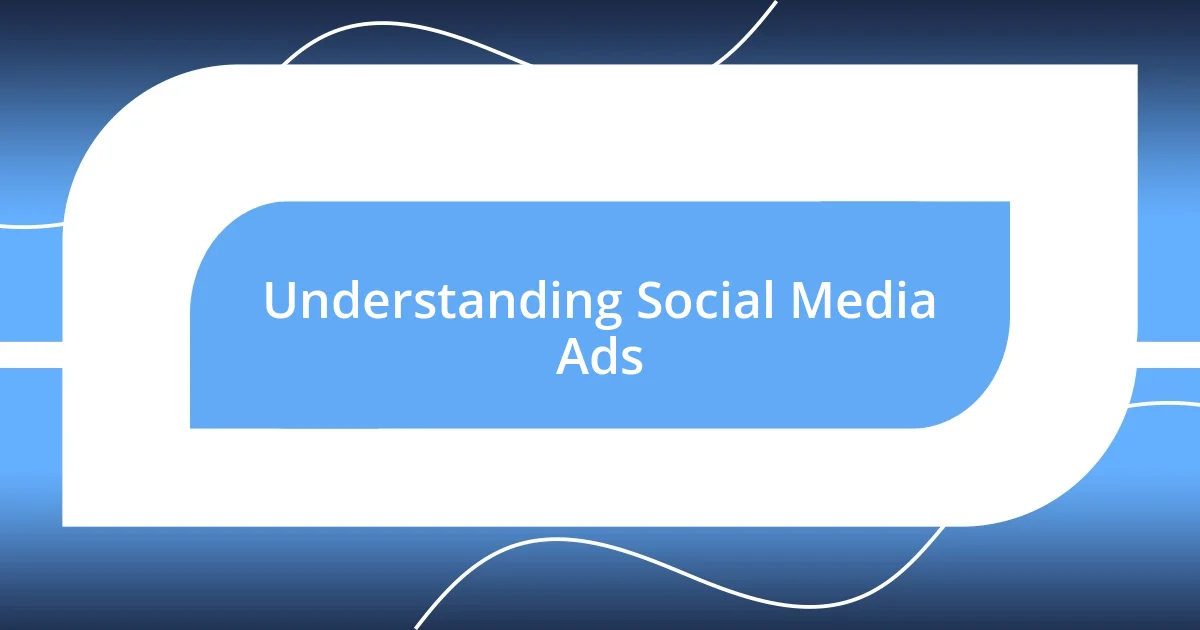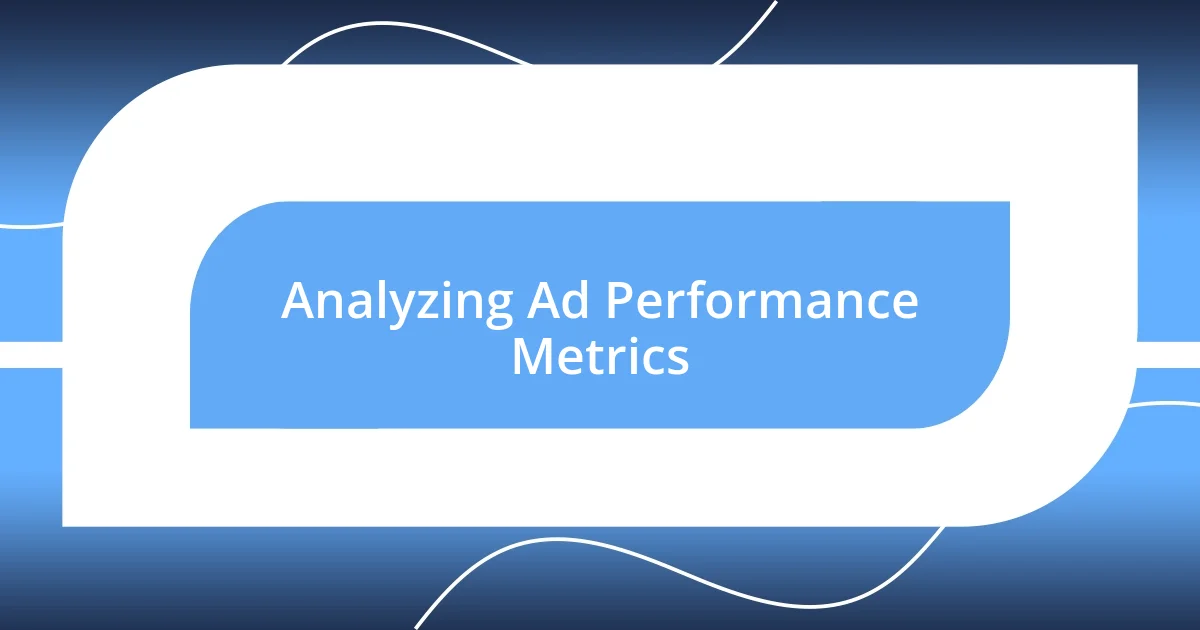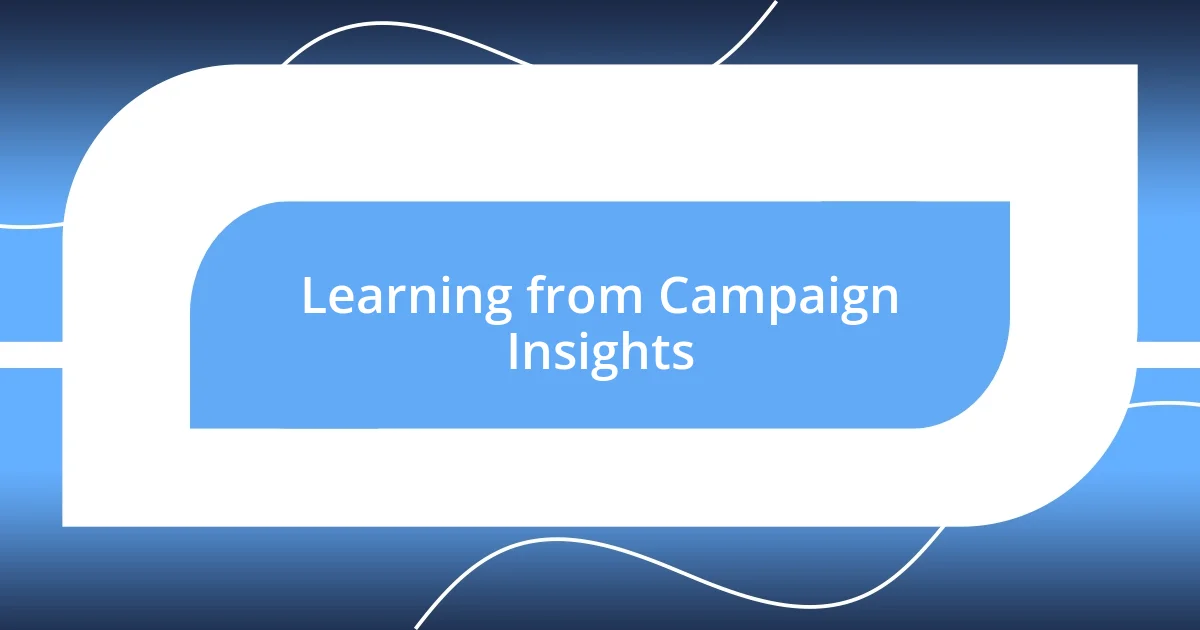Key takeaways:
- Understanding audience targeting is crucial; specificity in demographics, interests, and pain points enhances engagement.
- Setting clear, measurable objectives for campaigns ensures focused strategies and improved performance.
- Analyzing ad performance metrics helps identify strengths and weaknesses, allowing for continuous improvement and informed adjustments.

Understanding Social Media Ads
When it comes to social media ads, understanding the landscape can be quite overwhelming. I remember the first time I launched an ad campaign; I felt like I was standing at the edge of a vast ocean, unsure of how deep it went. Did I really know my audience? That initial confusion is something many face when dipping their toes into the world of targeted advertising.
These ads are more than just flashy images or catchy slogans; they are data-driven tools designed to connect brands with potential customers. I once received an ad that seemed eerily tailored to my interests. It was a brand I’d briefly mentioned in conversation, and I marveled at how effectively they had targeted me. How do they do that? It all boils down to leveraging user data—behaviors, interests, and demographics.
In essence, social media ads create an intimate connection between brands and users, almost like a conversation. I’ve often found myself engaging with brands simply because their ads spoke to me personally, tapping into my emotions. Have you ever had a moment like that? It’s fascinating how an ad can transform from a mere promotional tool into a relatable story that resonates deeply with our lives.

Choosing the Right Platform
Choosing the right platform for social media advertising can feel like piecing together a puzzle. I vividly recall my first attempt to decipher whether Instagram or Facebook was the better option for a product I was promoting. Facebook seemed to have a broader audience, but Instagram was vibrant and visually appealing, which matched my brand. In the end, I realized it wasn’t just about the platform itself, but about where my target audience spent their time.
Every platform has its unique strengths and weaknesses. For instance, I’ve noticed that LinkedIn works wonders for B2B advertising, fostering a professional tone that resonates well with business-oriented individuals. On the other hand, TikTok appeals to a younger demographic with its engaging and creative video content. Ultimately, picking the right platform hinges on understanding not just where people are, but how they interact and engage with content.
When considering a platform, one must think about the kind of ads they want to create. Back when I was launching my campaign, I found that video ads on platforms like TikTok garnered far more engagement than static images. Reflecting on that experience, I learned the importance of matching ad formats to the platform’s strengths to maximize impact and reach.
| Platform | Target Audience |
|---|---|
| Broad, diverse demographics | |
| Visual, lifestyle-focused users | |
| Professionals and businesses | |
| TikTok | Young, creative audience |

Setting Clear Objectives
Setting clear objectives for your social media ads is like charting a course before embarking on a journey. I’ve learned firsthand that without specific goals, campaigns can easily drift aimlessly, resulting in wasted budgets and missed opportunities. For instance, when I first dipped my toes into social media advertising, I naively thought that simply creating an ad was enough. It wasn’t until I set measurable objectives, like increasing website traffic by 30% within a month, that I noticed a marked improvement in my campaign’s performance.
To effectively set your objectives, consider these key points:
- Be Specific: Define what you want to achieve. Whether it’s brand awareness, lead generation, or sales conversion, clarity is key.
- Make it Measurable: Use metrics that indicate success, such as click-through rates or engagement levels.
- Align with Business Goals: Ensure that your social media objectives support your overall business strategy and vision.
- Set a Timeline: Determine when you want to achieve these goals to maintain momentum.
- Be Realistic: Goals should stretch your abilities but remain achievable within the set timeframe and resources.
In my journey, one particular campaign stands out. I focused on building my email list by promoting a lead magnet. By clearly defining my objective—growing my list by 200 subscribers within three months—I felt a renewed sense of purpose. Tracking progress became much more engaging, and I could adjust my strategies based on real-time data, ultimately leading to success beyond my expectations. Establishing clear objectives can truly transform the way you approach social media advertising, making it not just a task, but a thrilling pursuit of growth.

Crafting Engaging Ad Content
Crafting engaging ad content is an art that requires a blend of creativity and strategy. When I first started writing ads, I was surprised by just how much a single word could change the tone of the message. For instance, swapping out “buy now” for “discover your new favorite” instantly transformed the ad from a hard sell to an inviting option that piqued curiosity. Doesn’t it feel more appealing to uncover something special rather than being pressured into a purchase?
In my experience, visuals play a crucial role in grabbing attention. I still remember the first time I used vibrant colors and compelling images in an ad—it was like flipping a switch! The engagement levels shot up, proving that captivating visuals truly resonate with audiences. There’s magic in storytelling too; ads that tell a story often draw people in, making them feel connected to the brand. Can you recall an ad that made you pause because it told a story that felt personal?
To strike the right chord, it’s also essential to know your audience. I once crafted an ad targeted toward young parents, featuring relatable scenarios from their daily lives. The response was overwhelming! By tapping into their experiences, I created content that felt personal, and it sparked conversations in the comments. Understanding your audience not only sharpens your content but also builds a genuine connection, making them more likely to engage and take action. Wouldn’t you agree that the best ads aren’t just about selling but about forging a relationship?

Targeting Your Ideal Audience
Targeting your ideal audience can feel like a puzzle, but it’s so rewarding when you find the right pieces. I remember one campaign where I realized that simply casting a wide net wasn’t getting me anywhere. It wasn’t until I began to define my audience in detail—considering their interests, demographics, and online behaviors—that I saw a marked increase in engagement. Focusing on specific traits, such as being a sustainability-conscious millennial, helped me tailor my messaging perfectly. Have you ever experienced that “aha” moment when your audience finally clicks with your content?
To really connect with your audience, I’ve found that understanding their pain points is vital. For instance, when I created an ad targeting small business owners, I leaned into the challenges they face—like tight budgets and overwhelming competition. By showing empathy and providing solutions that addressed their specific needs, I received feedback that felt genuinely appreciative. It taught me that when your audience feels understood, they’re more likely to convert. Have you noticed how such an emotional connection can make the difference between a casual glance and a committed click?
Let’s not forget the beauty of experimentation. When I first targeted my ads based on location, age, and interests, the results were mixed. However, I didn’t let that discourage me. I kept tweaking my audience segments, testing different combinations, and monitoring how one small change could lead to big shifts in performance. This ongoing learning process turned the act of targeting into an exciting journey rather than a chore. Have you tried adjusting your audience criteria? You might be surprised by the results!

Analyzing Ad Performance Metrics
Analyzing ad performance metrics can be a bit like uncovering a treasure map—each data point leads you closer to understanding what works. I recall a moment when I dove deep into my campaign analytics and discovered that while impressions were high, clicks were disappointingly low. It hit me like a ton of bricks! This insight made me rethink my call-to-action and visual elements. Have you ever had a moment where the numbers just didn’t add up and made you question everything?
Engagement rates often reveal the emotional impact of ads better than any other metric. I once ran a video ad and was ecstatic to see a high view duration. Later, however, the shares were dismally low, which had me scratching my head. This experience taught me that even captivating content might not resonate with viewers enough for them to share it. It’s a balancing act—finding the sweet spot where interest translates to action. Have you contemplated how engagement feels on a deeper level, influencing not just clicks but shared experiences?
Furthermore, conversion rates are the ultimate proof of your ad’s effectiveness, and here’s where the analysis can get really interesting. Once, I had an ad that generated a decent conversion rate, but I noticed a significant drop-off in the final purchasing step. It was frustrating, but it also sparked curiosity. I decided to test different landing pages, and the results were enlightening. Each tweak revealed something new about what potential customers were looking for. Have you explored the entire customer journey, from impression to conversion? Understanding that journey can change everything about your approach to ads.

Learning from Campaign Insights
Recognizing trends in your campaign insights is crucial for growth. I remember launching a series of ads, only to find that one specific image outperformed the others by a landslide. It was intriguing to observe how minor visual elements influenced user interactions. Have you tracked which visuals resonate with your audience? Sometimes, even subtle shifts can lead to significant results.
Evaluating the feedback from your audience can open your eyes to new perspectives. A few months ago, I received comments on one of my ads that caught me off guard but ultimately impacted my strategy. Instead of brushing them off, I took the time to engage in conversations with some users. Their insights helped me refine my messaging, making it much more relatable. Have you ever turned criticism into constructive feedback?
Lastly, I learned the importance of timing from my campaign insights. During one particular promotion, I discovered that ads released in the early morning generated more engagement than those posted in the evening. It made me reconsider my scheduling strategy entirely. Timing can really be everything! Have you analyzed when your audience is most active? Understanding their behavior can be your secret weapon in social media advertising.














